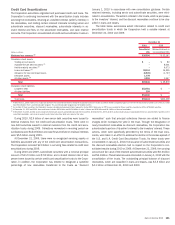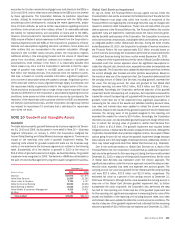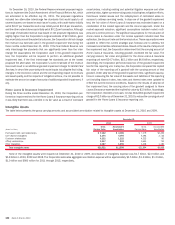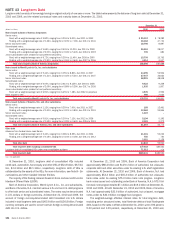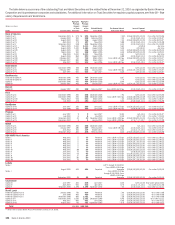Bank of America 2010 Annual Report Download - page 192
Download and view the complete annual report
Please find page 192 of the 2010 Bank of America annual report below. You can navigate through the pages in the report by either clicking on the pages listed below, or by using the keyword search tool below to find specific information within the annual report.
repurchase process and the Corporation has used that experience to record a
liability related to existing and future claims from such counterparties.
At December 31, 2010, the unpaid principal balance of loans related to
unresolved repurchase requests previously received from monolines was
$4.8 billion, including $3.0 billion in repurchase requests that have been
reviewed where it is believed a valid defect has not been identified which would
constitute an actionable breach of representations and warranties and
$1.8 billion in repurchase requests that are in the process of review. As
discussed on the previous page, a portion of the repurchase requests that are
initially denied are ultimately resolved through repurchase or make-whole
payments, after additional dialogue and negotiation with the monoline insurer.
At December 31, 2010, the unpaid principal balance of loans for which the
monolines had requested loan files for review but for which no repurchase
request had been received was $10.2 billion, excluding loans that had been
paid in full. There will likely be additional requests for loan files in the future
leading to repurchase requests. Such requests may relate to loans that are
currently in securitization trusts or loans that have defaulted and are no longer
included in the unpaid principal balance of the loans in the trusts. However, it
is unlikely that a repurchase request will be received for every loan in a
securitization or every file requested or that a valid defect exists for every loan
repurchase request. In addition, any claims paid related to repurchase
requests from a monoline are paid to the securitization trust and may be
used by the securitization trust to repay any outstanding monoline advances
or reduce future advances from the monolines. To the extent that a monoline
has not advanced funds or does not anticipate that it will be required to
advance funds to the securitization trust, the likelihood of receiving a repur-
chase request from a monoline may be reduced as the monoline would
receive limited or no benefit from the payment of repurchase claims. More-
over, some monolines are not currently performing their obligations under the
financial guaranty policies they issued which may, in certain circumstances,
impact their ability to present repurchase claims.
Whole Loan Sales and Private-label Securitizations
The Corporation and its subsidiaries have limited experience with private-label
securitization repurchases as the number of recent repurchase requests
received has been limited as shown in the outstanding claims table on
page 188. The representations and warranties, as governed by the private-
label securitizations, generally require that counterparties have the ability to
both assert a claim and actually prove that a loan has an actionable defect
under the applicable contracts. While a securitization trustee may always
investigate or demand repurchase on its own action, in order for investors to
direct the securitization trustee to investigate loan files or demand the
repurchase of loans, the securitization agreements generally require the
security holders to hold a specified percentage, such as 25 percent, of the
voting rights of the outstanding securities. In addition, the Corporation be-
lieves the agreements for private-label securitizations generally contain less
rigorous representations and warranties and higher burdens on investors
seeking repurchases than the comparable agreements with the GSEs.
The majority of repurchase requests that the Corporation has received
relate to whole loan sales. Most of the loans sold in the form of whole loans
were subsequently pooled with other mortgages into private-label securitiza-
tions issued by third-party buyers of the loans. The buyers of the whole loans
received representations and warranties in the sales transaction and may
retain those rights even when the loans are aggregated with other collateral
into private-label securitizations. Properly presented repurchase requests for
these whole loans are reviewed on a loan-by-loan basis. If, after the Corpo-
ration’s review, it does not believe a claim is valid, it will deny the claim and
generally indicate a reason for the denial. When the counterparty agrees with
the Corporation’s denial of the claim, the counterparty may rescind the claim.
When there is disagreement as to the resolution of the claim, meaningful
dialogue and negotiation between the parties is generally necessary to reach
conclusion on an individual claim. Generally, a whole loan sale claimant is
engaged in the repurchase process and the Corporation and the claimant
reach resolution, either through loan-by-loan negotiation or at times, through a
bulk settlement. Through December 31, 2010, approximately 17 percent of
the whole loan claims that the Corporation initially denied have subsequently
been resolved through repurchase or make-whole payments and 53 percent
have been resolved through rescission or repayment in full by the borrower.
Although the timeline for resolution varies, once an actionable breach is
identified on a given loan, settlement is generally reached as to that loan
within 60 to 90 days. When a claim has been denied and the Corporation does
not have communication with the counterparty for six months, the Corporation
views these claims as inactive; however, they remain in the outstanding
claims balance until resolution.
On October 18, 2010, Countrywide Home Loans Servicing, LP (which
changed its name to BAC Home Loans Servicing, LP), a wholly-owned sub-
sidiary of the Corporation, in its capacity as servicer on 115 private-label
securitizations, which was subsequently extended to 225 securitizations,
received a letter that asserts breaches of certain servicing obligations,
including an alleged failure to provide notice of breaches of representations
and warranties with respect to mortgage loans included in the transactions.
Additionally, the Corporation received new claim demands totaling $1.7 billion
in correspondence from private-label securitization investors. Private-label
securitization investors generally do not have the contractual right to demand
repurchase of loans directly or the right to access loan files. The inclusion of
the $1.7 billion in outstanding claims does not mean that the Corporation
believes these claims have satisfied the contractual thresholds required for
the private-label securitization investors to direct the securitization trustee to
take action or are otherwise procedurally or substantively valid.
Liability for Representations and Warranties and
Corporate Guarantees
The liability for representations and warranties and corporate guarantees is
included in accrued expenses and other liabilities and the related provision is
included in mortgage banking income.
The table below presents a rollforward of the liability for representations
and warranties and corporate guarantees.
(Dollars in millions)
2010 2009
Liability for representations and warranties and
corporate guarantees, beginning of year
$3,507
$2,271
Merrill Lynch acquisition
–
580
Additions for new sales
30
41
Charge-offs
(4,803)
(1,312)
Provision
6,786
1,851
Other
(82)
76
Liability for representations and warranties
and corporate guarantees, December 31
$5,438
$3,507
The liability for representations and warranties has been established
when those obligations are both probable and reasonably estimable. As
previously discussed, the Corporation reached agreements with the GSEs
resolving repurchase claims involving certain residential mortgage loans sold
to them by entities related to legacy Countrywide. The Corporation’s liability
for obligations under representations and warranties given to the GSEs
considers the recent agreements and their impact on the repurchase rates
on future claims that may be received on loans that have defaulted or that are
estimated to default. The Corporation believes that its remaining exposure to
repurchase obligations for first-lien residential mortgage loans sold directly to
the GSEs has been accounted for as a result of these agreements and the
associated adjustments to the recorded liability for representations and
190 Bank of America 2010



